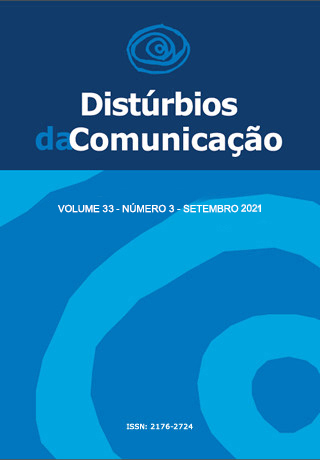Effects of weight and gestational age on infants’ auditory pathway
DOI:
https://doi.org/10.23925/2176-2724.2021v33i3p537-544Keywords:
Infant, Newborn, Hearing, Electrophysiology, Birth weight, Hearing disordersAbstract
Introduction: Infants born with low birth weight in relation to their gestational age are more prone to neonatal and infant morbidity and mortality. Brainstem Auditory Evoked Potential (BAEP) is a useful tool to investigate the neuroelectric activity of the auditory pathway of brainstem. Objective: To investigate the birth weight and gestational age effect on the infants’ auditory pathway. Methods: cross-sectional study, conducted in a public hospital from January 2017 to December 2018 composed by small-for-gestational-age (SGA) born infants in the study group, and appropriate-for-gestational-age (AGA) infants, as control group. Both groups were similar in relation to gestational age, risk indicators for hearing loss, and age at the moment of audiological evaluation. All of them were submitted to the exams of transient otoacoustic emissions and BAEP. Results: 172 infants participated, with an average age of 1.3 months for those born SGA and 1.5 months for AGA. In the evaluation using the BAEP, there was a significant increase only in the values of the absolute latencies; however, the median values of both absolute and interpeak latencies were similar between them. Conclusion: The birth weight and gestational age effect in infants born weighing less than the 10th percentile, did not demonstrate impairment on the auditory pathway in the first month of life.
Downloads
References
Metz TD, Lynch AM, Wolfe P, Barry JS, Galan HL. J. Effect of small for gestational age on hemodynamic parameters in the neonatal period. Matern Fetal Neonatal Med. 2012; 25(10): 2093-7.
Schlaudecker EP, Munoz MFM, Bardají A, Boghossian NS, Khalil A, Mousa H, Mirjana Nesi, et.al. Small for gestational age: case definition & guidelines for data collection, analysis, and presentation of maternal immunization safety data Vaccine. 2017; 35 (48Part A): 6518-28.
Sharma D, Shastri S, Farahbakhsh N, Sharma P. Intrauterine growth restriction- part 1. J Matern Fetal Neonatal Med. 2016; 29(24):3977-87.
McCowan LM, Figueras F, Anderson NH. Evidence-based national guidelines for the management of suspected fetal growth restriction: comparison, consensus, and controversy. Am.J.Obstetr.Gynecol. 2018; 218(2S): 55-68.
Malhotra A, Allison BJ, Castillo-Melendez M, Jenkin G, Polglase GR, Miller ZL. Neonatal morbidities of fetal growth restriction: pathophysiology and impact. Front Endocrinol. 2019; 10: 55.
Goldenberg RL, Cliver SP. Small for gestational age and intrauterine growth restriction: definitions and standards. Clin Obstet Gynecol. 1997; 40(4): 704-14.
Narchi H, Skinner A, Williams B. Small for gestational age neonates-are we missing some by only using standard population growth standards and does it matter? J Matern Fetal Neonatal Med. 2010; 23(1): 48-54.
Miller SL, Huppi PS, Mallard C. The consequences of fetal growth restriction on brain structure and neurodevelopmental outcome. J Physiol. 2016; 594(4):807-23.
Monden CW, Smits J. Maternal height and child mortality in 42 developing countries. Am J Hum Biol. 2009; 21(3): 305-11.
Lekskulchai R, Cole J. Effect of a developmental program on motor performance in infants born preterm. Aus J Physiother. 2001; 47(3): 169-76.
Saintonge J, Lavoie A, Lachapelle J, Côté R. Brain maturity in regard to the auditory brainstem response in small-for-date neonates. Brain Dev. 1986; 8(1): 1-5.
Gorga MP, Kaminski JR, Beauchaine KL, Jesteadt W, Neely ST. Auditory brainstem responses from children three months to three years of age: normal patterns of response. J Speech Hear Res.1989; 32(2): 281-8.
Kohelet D, Arbel E, Goldberg M, Arlazzoroff A. Intrauterine growth retardation and brainstem auditory-evoked response in preterm infants. ActaPaediatr. 2000; 89(1): 73-6.
Jiang ZD, Chen C, Wilkinson AR. Brainstem auditory response findings in term neonates in intensive care unit. J Matern Fetal Neonatal Med. 2012; 25(12): 2746-9.
Jiang ZD. Neural conduction abnormality in the brain stem and prevalence of the abnormality in late preterm infants with perinatal problems. Eur J Pediatr. 2013; 172(8): 1033-8.
Stevens J, Brennan S, Gratton D, Campbell M. ABR in newborns: effects of electrode configuration, stimulus rate, and EEG rejection levels on test efficiency. Int J Audiol. 2013; 52(10): 706-12.
Sarda P, Dupuy RP, Boulot P, Rieu D. Brainstem conduction time abnormalities in small for gestational age infants. J Perinat Med 1992; 20(1): 57–63.
AngrisaniI RMG, Azevedo MF, Carvallo RMM, Diniz EMA, Ferraro AA, Guinsburg R, et al. Electrophysiological characterization of hearing in small for gestational age premature infants. CoDAS. 2013; 25(1): 22-8.
Fenton TR, Kim JH. A systematic review and meta-analysis to revise the Fenton growth chart for preterm infants. Pediatrics. 2013; 13: 59.
Year 2019 position statement: principles and guidelines for early hearing detection and intervention programs. J.Early Hear Detect. Interv. 2019; 4(2): 1-44.
Côrtes-Andrade, Freixo I, Bento DV, Lewi DR. Emissions (TEOE): Newborn Hearing Screening Program Protocols. Revista CEFAC. 2013;15(3): 521-7.
Jiang ZD, Wu YY, Zhen MS, Sun DK, Feng LY, Peng YM, et al. Development of early and late brainstem conduction time in normal and intrauterine growth retarded children. Acta Paediatr Scand. 1991; 80(5): 494-9.
Onis M, Garza C, Victora CG, Onyango AW, Frongillo EA, Martines J. The who multicentre growth reference study: planning, study design, and methodology. Food Nutr Bull. 2004; 25 (1 Suppl): 15-26.
Hood LJ. Auditory neuropathy/dys-synchrony disorder: diagnosis and management. Otolaryngol Clin North Am. 2015; 48(6): 1027-40.
Sharma M, Bist SS, Kumar S. Age related maturation of wave V latency of auditory brainstem response in children. J Audiol Otol. 2016 Sep; 20(2): 97-101.
Angrisani RG, Diniz EMA, Guinsburg R, Ferraro AA, Azevedo MF, Matas CG. Auditory pathway maturational study in small for gestational age preterm infants. CoDAS. 2014; 26(4): 286-93
Jiang ZD, Li ZH. Mild maturational delay of the brainstem at term in late preterm small-for-gestation age babies. Early Human Development. 2015; 91(4): 265-9.
Sininger YS, Cone-Wesson B. Lateral asymmetry in the ABR of neonates: evidence and mechanisms. Hear Res. 2006; 212(1-2): 203-11.
Downloads
Published
Issue
Section
License
Copyright (c) 2021 Georgea Espindola Ribeiro, João César Lyra, Daniela Polo Carmargo da Silva

This work is licensed under a Creative Commons Attribution 4.0 International License.









